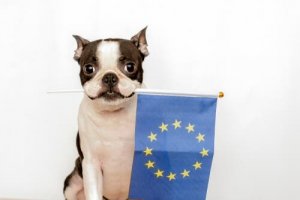The European Convention for the Protection of Pet Animals


Written and verified by the lawyer Francisco María García
Every country should have a strong legal framework for animal protection. Many countries in Europe have the European Convention for the Protection of Pet Animals.
In early 2018, Spain finally decided to join the countries that ratified the European Convention for the Protection of Pet Animals. As a result, Spain became the eighteenth country in the region to join the initiative. These countries are committed to legally advance the fight against animal abuse and neglect.
Even though Spain only recently joined, the agreement was created more than three decades ago. Officially, the agreement was published in 1987. This took place almost ten years after the UNESCO proclaimed the Declaration of Animal Rights.
The publication of the European Convention for the Protection of Pet Animals established a new framework for animal welfare laws in Europe. Although the group doesn’t have the power to legislate in individual countries, it has acted as a call for change. In this way, it promoted legal changes in Europe. Additionally, it has also helped expand public policies focused on pets. For example, this is true concerning the legality of seizures.
What is the European Convention for the Protection of Pet Animals?
As the name suggests, this is a regulatory group that European countries can join. The text of the agreement highlights the main objective of its creation: to promote specific measures to improve the protection of pets.
To be more exact, the preamble of the Convention establishes that all people have a moral obligation to respect all living beings. Therefore, animal welfare laws don’t stem from temporary political circumstances. Instead, they come from the ethical responsibility of all human beings.

We should always remember that, regardless of context, it’s our duty to ensure that all species have what they need to live in a dignified way.
As a result, the agreement highlights the emotional, cognitive, and historical bond that unites us with companion animals. These animals impact our quality of life at both an individual and a social level. In this way, the convention focuses on the good practices that promote responsible care for pets.
The agreement also promotes a series of public policies and specific legal measures to fight animal abuse and neglect. In addition, it details the consequences of abuse, such as public concerns caused by homeless animals.
Contributions of the convention
One of the main contributions of the convention to animal welfare has been the prohibition of aesthetic mutilations. Historically, many breeds have been exposed to mutilation, such as ear or tail cutting, in order to meet certain aesthetic standards. Another contribution is a guarantee to consider animal welfare when performing certain activities, such as hunting.
However, by ratifying the European Convention, the countries are committing to prohibit these practices through specific regulations. For example, in Spain, this ratification was a great step in the unification between various regional regulations.
On the other hand, these new regulations have caused conflicts with hunters. Hunters often claim they are harmed by the extreme concepts of animal activists.
For example, in addition to regulations on sport hunting, the Convention also regulates the use of animals in recreational activities. According to the agreement, people can only use animals in activities that don’t involve any type of pain, humiliation, suffering, or risk to their physical or cognitive integrity.

Governments promoting animal welfare
Another contribution of the European Convention for the Protection of Pet Animals is expressly giving governments the responsibility of promoting public policies that encourage adoption and responsible ownership. For example, under the agreement, governments are responsible for raising awareness of effective contraceptive methods.
The agreement also affirms the importance of adopting specific measures to combat the abandonment of animals. Abandoning animals leads to a rapid increase in the number of homeless street animals. However, since the ratification of the agreement, all participating countries have approved more rigid sanctions for abandoning or mistreating animals.
Moreover, discussion of animal abuse in legal texts has changed and expanded over time. Today, for example, this term covers not only physical abuse, but also cognitive or emotional abuse. As a result, any type of abuse, violence, or exploitation can be sanctioned as animal abuse in Europe.
Every country should have a strong legal framework for animal protection. Many countries in Europe have the European Convention for the Protection of Pet Animals.
In early 2018, Spain finally decided to join the countries that ratified the European Convention for the Protection of Pet Animals. As a result, Spain became the eighteenth country in the region to join the initiative. These countries are committed to legally advance the fight against animal abuse and neglect.
Even though Spain only recently joined, the agreement was created more than three decades ago. Officially, the agreement was published in 1987. This took place almost ten years after the UNESCO proclaimed the Declaration of Animal Rights.
The publication of the European Convention for the Protection of Pet Animals established a new framework for animal welfare laws in Europe. Although the group doesn’t have the power to legislate in individual countries, it has acted as a call for change. In this way, it promoted legal changes in Europe. Additionally, it has also helped expand public policies focused on pets. For example, this is true concerning the legality of seizures.
What is the European Convention for the Protection of Pet Animals?
As the name suggests, this is a regulatory group that European countries can join. The text of the agreement highlights the main objective of its creation: to promote specific measures to improve the protection of pets.
To be more exact, the preamble of the Convention establishes that all people have a moral obligation to respect all living beings. Therefore, animal welfare laws don’t stem from temporary political circumstances. Instead, they come from the ethical responsibility of all human beings.

We should always remember that, regardless of context, it’s our duty to ensure that all species have what they need to live in a dignified way.
As a result, the agreement highlights the emotional, cognitive, and historical bond that unites us with companion animals. These animals impact our quality of life at both an individual and a social level. In this way, the convention focuses on the good practices that promote responsible care for pets.
The agreement also promotes a series of public policies and specific legal measures to fight animal abuse and neglect. In addition, it details the consequences of abuse, such as public concerns caused by homeless animals.
Contributions of the convention
One of the main contributions of the convention to animal welfare has been the prohibition of aesthetic mutilations. Historically, many breeds have been exposed to mutilation, such as ear or tail cutting, in order to meet certain aesthetic standards. Another contribution is a guarantee to consider animal welfare when performing certain activities, such as hunting.
However, by ratifying the European Convention, the countries are committing to prohibit these practices through specific regulations. For example, in Spain, this ratification was a great step in the unification between various regional regulations.
On the other hand, these new regulations have caused conflicts with hunters. Hunters often claim they are harmed by the extreme concepts of animal activists.
For example, in addition to regulations on sport hunting, the Convention also regulates the use of animals in recreational activities. According to the agreement, people can only use animals in activities that don’t involve any type of pain, humiliation, suffering, or risk to their physical or cognitive integrity.

Governments promoting animal welfare
Another contribution of the European Convention for the Protection of Pet Animals is expressly giving governments the responsibility of promoting public policies that encourage adoption and responsible ownership. For example, under the agreement, governments are responsible for raising awareness of effective contraceptive methods.
The agreement also affirms the importance of adopting specific measures to combat the abandonment of animals. Abandoning animals leads to a rapid increase in the number of homeless street animals. However, since the ratification of the agreement, all participating countries have approved more rigid sanctions for abandoning or mistreating animals.
Moreover, discussion of animal abuse in legal texts has changed and expanded over time. Today, for example, this term covers not only physical abuse, but also cognitive or emotional abuse. As a result, any type of abuse, violence, or exploitation can be sanctioned as animal abuse in Europe.
All cited sources were thoroughly reviewed by our team to ensure their quality, reliability, currency, and validity. The bibliography of this article was considered reliable and of academic or scientific accuracy.
- Instrumento de ratificación del Convenio Europeo sobre protección de animales de compañía. Extraído de: https://boe.es/diario_boe/txt.php?id=BOE-A-2017-11637
- Ley 5/1997, de 24 de abril, de protección de los animales de compañía. Extraído de: https://www.boe.es/buscar/pdf/1997/BOE-A-1997-14412-consolidado.pdf
This text is provided for informational purposes only and does not replace consultation with a professional. If in doubt, consult your specialist.








